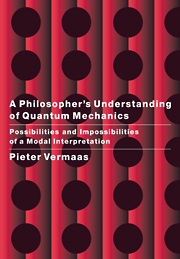 A Philosopher's Understanding of Quantum Mechanics
A Philosopher's Understanding of Quantum Mechanics Book contents
- Frontmatter
- Contents
- Preface
- 1 Introduction
- 2 Quantum mechanics
- 3 Modal interpretations
- Part one Formalism
- 4 The different versions
- 5 The full property ascription
- 6 Joint property ascriptions
- 7 Discontinuities, instabilities and other bad behaviour
- 8 Transition probabilities
- 9 Dynamical Autonomy and Locality
- Part two Physics
- Part three Philosophy
- Appendix A From the bi to the spectral modal interpretation
- Glossary
- Bibliography
- Index
5 - The full property ascription
Published online by Cambridge University Press: 28 October 2009
- Frontmatter
- Contents
- Preface
- 1 Introduction
- 2 Quantum mechanics
- 3 Modal interpretations
- Part one Formalism
- 4 The different versions
- 5 The full property ascription
- 6 Joint property ascriptions
- 7 Discontinuities, instabilities and other bad behaviour
- 8 Transition probabilities
- 9 Dynamical Autonomy and Locality
- Part two Physics
- Part three Philosophy
- Appendix A From the bi to the spectral modal interpretation
- Glossary
- Bibliography
- Index
Summary
The different modal interpretations all advance a core property ascription {〈Pj,Cαj〉}j. This chapter is about how this core property ascription fixes the full property ascription. I start with some logic and algebra. I then present two existing proposals for determining the full property ascriptions as well as four conditions one can impose on them. Lastly I give my own proposal and end by discussing how the full property ascription leads to a value assignment to magnitudes.
Some logic and algebra
To prepare the ground for discussing the full property ascription, I firstly define the logical connectives (negation, conjunction and disjunction) for properties. Then because, as discussed in Section 4.1, all the modal interpretations which I consider give up on the idea that thefull property ascription assigns definite values to all properties, I secondly define two types of subsets of properties: Boolean algebras and faux-Boolean algebras.
I have already assumed that every property Qα pertaining to a system α is represented by one and only one projection Qα defined on the Hilbert space ℋα associated with α. Each projection Qα in its turn corresponds one-to-one to the subspace of ℋα, denoted by 2α, onto which it projects. One thus has a bijective mapping from a property Qα to a projection Qα to a subspace 2α. For the set of subspaces of a Hilbert space one can in a natural way define an orthocomplement, a meet and a join. I now choose45 to define the logical connectives for properties pertaining to a system by means of this orthocomplement, meet and join for subspaces and the bijective mapping between properties and subspaces (by means of an isomorphism, more shortly).
- Type
- Chapter
- Information
- A Philosopher's Understanding of Quantum MechanicsPossibilities and Impossibilities of a Modal Interpretation, pp. 63 - 86Publisher: Cambridge University PressPrint publication year: 2000


